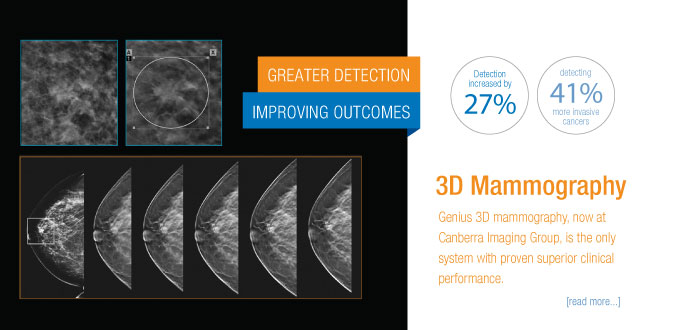Canberra Imaging Group is proud to bring the latest in Mammography technology to Goulburn.
Genius 3D mammography is the only system with proven superior clinical performance. It helps eliminate most detection challenges found in 2D mammography
Breast tissue is examined layer by layer with the X-ray arm sweeping in an arc over the breast, taking a series of images at various angles. Women with dense breasts will benefit from the sweeping technique, images are 1mm apart and this increases the accuracy of the diagnosis.
At Canberra Imaging Group mammography is generally followed by an ultrasound of the breast, which increases the accuracy of the diagnosis, which in turn improves patient outcomes.
Breast cancer is the most common cancer diagnosed in women, representing 28% of all cancers in females (2,3). Early detection through regular mammograms is the best defence against breast cancer (1) and there is a significant increased chance of survival if abnormalities are found early (1).
Genius 3D Mammography, now at Canberra Imaging Group (CIG), is the only system with proven superior clinical performance (5,7,8,9).
- Clinically, 3D mammography is gaining efficacy and improving outcomes (5)
- 3D mammography detects 41% more invasive cancers than 2D alone (5)
- Studies show a 15-40% reduction in recall rates (5)
- Cancer detection is increased by 27% overall (5)
- Patients across all age groups and breast densities benefit from 3D mammography (6)
- By minimising structure overlap, 3D mammography optimally demonstrates masses and architectural distortion (4)
To book 3D Mammography and Tomosynthesis, phone 1300 788 508 or complete our online form to request a booking.
To see the details of our new machine, the Selenia Dimensions 3D Mammography System, please visit the Hologic website here.
Images courtesy of Hologic Inc and affiliates.
